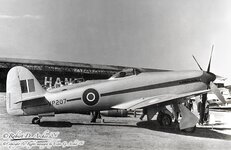Navigation
Install the app
How to install the app on iOS
Follow along with the video below to see how to install our site as a web app on your home screen.
Note: This feature may not be available in some browsers.
More options
You are using an out of date browser. It may not display this or other websites correctly.
You should upgrade or use an alternative browser.
You should upgrade or use an alternative browser.
Fastest Piston Engined Aircraft of WW2? (1 Viewer)
- Thread starter Gimmeacannon!
- Start date
Ad: This forum contains affiliate links to products on Amazon and eBay. More information in Terms and rules
More options
Who Replied?GrauGeist
Generalfeldmarschall zur Luftschiff Abteilung
Maybe not out of Spite, but perhaps Fury? 

wuzak
Captain
Note that there was just one Spiteful XVI built and it didn't hit 494 until 1947.
Wiki says 2 Spiteful F.16 were built, but BAE systems say only 1.
17 production and 2 prototype Spiteful F.14s were built. The F.14 was a laggard with a top speed of only 483mph. The first production Spiteful F.14 flew in April 1945.
Is that an early version with the 4 bladed prop?
wuzak
Captain
Is that an early version with the 4 bladed prop?
That's the prototype Fury.
GrauGeist
Generalfeldmarschall zur Luftschiff Abteilung
This was the first Fury prototype (NX798) built to F.2/43, with a Centaurus XII engine and the Rotol four-bladed prop.Is that an early version with the 4 bladed prop?
Admiral Beez
Major
Imagine if the Seafang had made it to the Pacific, facing 340 mph Zeros? Those IJN will be sitting still when a 460 mph Seafang zooms past.Never knew the the Spiteful was so fast.
Here's an imposter mimicking the first (semi) naval prototype SR661...
 Sea Typhoon descendant
Sea Typhoon descendant
This modern representation is a Baghdad Fury. The first fully navalised prototype with folding wings was SR666.
This modern representation is a Baghdad Fury. The first fully navalised prototype with folding wings was SR666.
Mike Williams
Senior Airman
- 572
- Oct 19, 2006
That's a nice looking airplane.
GrauGeist
Generalfeldmarschall zur Luftschiff Abteilung
Agreed!That's a nice looking airplane.
fastmongrel
1st Sergeant
Sea Furies just look right, not pretty not angry just right. Everything seems to be in the right position and the right proportion. No horrible zit like lumps and bumps stuck on as an afterthought.
Obviously a good deck aircraft as well, iirc it was HMAS Sydney that didn't have a single landing or taking off accident while on station off Korea. Breaking records for numbers of take off and landing cycles without loss. Obviously a lot of that was a great crew but having two such docile aircraft like the Sea Fury and Firefly helped.
Obviously a good deck aircraft as well, iirc it was HMAS Sydney that didn't have a single landing or taking off accident while on station off Korea. Breaking records for numbers of take off and landing cycles without loss. Obviously a lot of that was a great crew but having two such docile aircraft like the Sea Fury and Firefly helped.
Sea Furies just look right, not pretty not angry just right.
One of my faves.
Howard Gibson
Senior Airman
Is this not something like a Griffon 85 engine?
Now, if they made it like this to start with maybe there would have been a Griffon Fury.
 hawkertempest.se
hawkertempest.se

Mark III+IV
AMCKen
Senior Airman
BlackSheep
Banned
- 443
- May 31, 2018
While you're making the high-performance mods, don't forget the stereo and amp dials that go up to 11….you know, because 11 is more than 10..Well, you should have used "300 mph tape" instead, just imagine the net gain if you had!

GregP
Major
The Hornet prototype RR 915 first flew on 28 July 1944 with Geoffrey de Havilland Jr. at the controls. Powered by twin Merlin engines, it was the fastest piston-engined fighter in Royal Air Force service. The Hornet also has the distinction of being the fastest wooden aircraft ever built and the second fastest operational twin propeller-driven aircraft — being slightly slower than the unconventional German Dornier Do 335 of 1945.
The prototype achieved 485 mph (780 km/h) in level flight, which came down to 472 mph (760 km/h) in production aircraft.
The first 10 Do 335 A-0s were delivered for testing in May. By late 1944, the Do 335 A-1 was on the production line. This was similar to the A-0 but with the uprated DB 603 E-1 engines and two underwing hardpoints for additional bombs, drop tanks or guns. It was capable of a maximum speed of 763 km/h (474 mph) at 6,500 m (21,300 ft) with MW 50 boost, or 686 km/h (426 mph) without boost, and able to climb to 8,000 m (26,250 ft) in under 15 minutes. Even with one engine out, it could reach about 563 km/h (350 mph).
Pretty hot for an aircraft that didn't fight anything.
If you are talking combat aircraft, you'd have to exclude the Do 335 since the only combat it saw was, on a test flight, to run away from a flight of Tempests without shooting anything or bombing anything. Flight tests don't count as combat unless there WAS combat.
Users who are viewing this thread
Total: 2 (members: 0, guests: 2)

